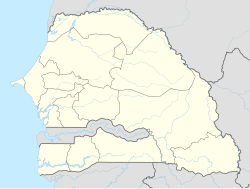This article needs additional citations for verification. (January 2016) |
Kolda (Arabic: كولدا; Wolof: Koldaa) is a city and urban commune located in southern Senegal. It is the capital city of Kolda Region and Kolda Department, a region known historically and popularly as Haute Casamance.
Kolda
كولدا | |
|---|---|
City and commune | |
 Kolda town centre market | |
| Coordinates: 12°53′N 14°57′W / 12.883°N 14.950°W | |
| Country | |
| Region | Kolda |
| Department | Kolda |
| Government | |
| • Mayor | Bécaye Diop |
| Area | |
• City and commune | 39.24 km2 (15.15 sq mi) |
| Elevation | 34 m (100 ft) |
| Population (2023 census)[1] | |
• City and commune | 103,574 |
| • Density | 2,600/km2 (6,800/sq mi) |
| Time zone | UTC+0 (GMT) |
History
editThe name Kolda derives from the name of the city's founder Koly Dado who first created a settlement near the shores of the Casamance River.
Administration
editKolda is the chief city of Kolda Department and of the Kolda Region.
Geography
editThe city is located on National Road 6, also called the "southern route" due to the fact that it goes from Dakar to Ziguinchor through Tambacounda, Vélingara and Kolda. Dakar, the capital city of Sénégal, is located 670 kilometers from Kolda.
Local administrative districts include Bantanguel, Doumassou, Ndiobène, Sarè Moussa, Gadapara, Sarè Kemo, Sinthiang Tountouroung, Sinthiang Idriss, Escale, Sikilo, and Faraba. Kolda is the main capital of the region incorporating the two departments of Velingara and Fafacourou.
Physical geology and climate
editBoth vegetation and rainfall are abundant in Kolda. The wet season lasts for five months, from June through October. The dry season begins in November and ends in May.
The annual average temperature is 81.9 °F with a maximum of 94.8 °F in April, May and October, and a minimum of 68.7 °F in January and August.
| Climate data for Kolda (1991–2020) | |||||||||||||
|---|---|---|---|---|---|---|---|---|---|---|---|---|---|
| Month | Jan | Feb | Mar | Apr | May | Jun | Jul | Aug | Sep | Oct | Nov | Dec | Year |
| Mean daily maximum °C (°F) | 35.5 (95.9) |
38.0 (100.4) |
40.4 (104.7) |
41.5 (106.7) |
40.8 (105.4) |
37.2 (99.0) |
33.4 (92.1) |
32.3 (90.1) |
32.9 (91.2) |
34.5 (94.1) |
35.7 (96.3) |
35.0 (95.0) |
36.4 (97.5) |
| Mean daily minimum °C (°F) | 14.5 (58.1) |
17.1 (62.8) |
20.2 (68.4) |
22.5 (72.5) |
24.2 (75.6) |
24.8 (76.6) |
24.0 (75.2) |
23.6 (74.5) |
23.2 (73.8) |
23.2 (73.8) |
18.8 (65.8) |
14.6 (58.3) |
20.9 (69.6) |
| Average precipitation mm (inches) | 0.1 (0.00) |
0.1 (0.00) |
0.0 (0.0) |
0.1 (0.00) |
19.0 (0.75) |
121.5 (4.78) |
248.9 (9.80) |
318.4 (12.54) |
265.4 (10.45) |
81.7 (3.22) |
2.6 (0.10) |
0.0 (0.0) |
1,057.8 (41.65) |
| Average precipitation days (≥ 1.0 mm) | 0.0 | 0.0 | 0.0 | 0.0 | 1.3 | 7.4 | 14.2 | 16.9 | 16.0 | 6.1 | 0.3 | 0.0 | 62.2 |
| Mean monthly sunshine hours | 254.2 | 246.4 | 269.7 | 270.0 | 275.9 | 237.0 | 210.8 | 192.2 | 210.0 | 238.7 | 246.0 | 235.6 | 2,886.5 |
| Mean daily sunshine hours | 8.2 | 8.8 | 8.7 | 9.0 | 8.9 | 7.9 | 6.8 | 6.2 | 7.0 | 7.7 | 8.2 | 7.6 | 7.9 |
| Source: NOAA[2] (sun 1961-1990)[3] | |||||||||||||
Demographics
editAs 2002, Kolda's population was 53,921. In 2007, official estimations, numbered the population at 62,258 inhabitants. The majority population is members of the Fula ethnic group. Mandinke and Jola ethnic groups are also present.
Economy
editA Center of Zootechniques Research (CRZ) was established in Kolda in 1972. Major crops include cotton, cereals like miley, fonio, peanut and another vegetables. Kolda also has major sheep, cattle, and dairy production. Kolda is abundant in fruits such as mangoes, oranges, and acajou nuts.
Notables
edit- Cherif Mohamed Aly Aidara - Islamic religious leader and founder of international NGO Mozdahir (born in Darou Hidjiratou)[4]
- Sidney Toure (poet, actor, activist)
- Moriba Pascal Doumbia (educator)
- El Hadj Omar Fall (educator)
- Mère Henry Ronk (Catholic Mission) - caregiver
- Ablaye Diallo (Zal), footballer
- Massamba Sambou, football player
- Souleymane Diamanka, poet
- Ablaye Cissoko, Singer, Musician
- General Ameth Fall
- Sada Kane, journalist
- Barou Balde, Adjunct Mayor
- Bécaye Diop, Minister of State, Minister of the Armed Forces, and Mayor of Kolda
References
edit- ^ a b Citypopulation.de Population and area of Kolda Commune
- ^ "World Meteorological Organization Climate Normals for 1991-2020 — Kolda". National Oceanic and Atmospheric Administration. Retrieved 9 January 2024.
- ^ "World Meteorological Organization Climate Normals for 1961-1990: Kolda". National Oceanic and Atmospheric Administration. Retrieved 4 August 2024.
- ^ Leichtman, Mara A. 2015. Shi'i Cosmopolitanisms in Africa: Lebanese Migration and Religious Conversion in Senegal. Indiana University Press.
